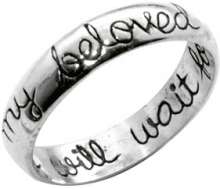Purity ring

Purity rings (also known as promise rings, abstinence rings, or chastity rings) are worn as a sign of chastity. The practice originated in the United States in the 1990s among Christian-affiliated sexual abstinence groups.[1][2] Wearing a purity ring is typically accompanied by a religious vow to practice abstinence until marriage.[3] Chastity rings are part of the abstinence-only sex education movement. Those who wear or promote these rings argue that the only method for safe sex is abstinence.[2]
Even though research suggests that purity rings are most effective when a child asks to take a purity pledge and wear the ring, it is often parents who initiate purity pledges. Parents list many reasons for believing that purity pledges and rings are necessary: sex is dangerous and leads to sexually transmitted diseases; purity rings can help to prevent pregnancy; boys will often be assertive or aggressive when seeking sex from girls; young girls who have sex are often shamed, yet they are also pressured to have sex by many of their peers; and popular media often encourages children to have sex. Despite these fears, some research suggests purity rings have little to no effect.[4]
David Bario of the Columbia News Service wrote:[5]
Under the Bush administration, organizations that promote abstinence and encourage teens to sign virginity pledges or wear purity rings have received federal grants. The Silver Ring Thing, a subsidiary of a Pennsylvania evangelical church, has received more than $1 million from the government to promote abstinence and to sell its rings in the United States and abroad.
In 2005 the ACLU of Massachusetts brought charges against this decision, alleging that the Silver Ring program did not ensure its secularity and hence was ineligible for federal funding due to the Establishment Clause of the First Amendment. The settlement between the ACLU and the U.S. Department of Health and Human Services (HHS) says that any further similar applications of Silver Ring Thing must be reported to ACLU and closely scrutinized for separation of church and state.[2]
Miss Manners advises that "polite society does not recognize such a thing as a chastity ring. It is so polite that it presumes that a lady is chaste unless publicly proven otherwise."[6]
Many celebrities, including Miley Cyrus, Jessica Simpson and the Jonas Brothers, among others, have worn purity rings.[7]
See also
References
- ↑ "Teen Pledges Barely Cut STD Rates, Study Says". washingtonpost.com. 2005-03-19. Retrieved 2011-12-11.
- 1 2 3 Stephanie Rosenbloom (2005-12-08). "A Ring That Says No, Not Yet". Nytimes.com. Retrieved 2014-05-01.
- ↑ "Vernacular Abstinence". Practical Matters Journal. 2001-09-11. Retrieved 2011-12-11.
- ↑ Jimmie Manning (23 October 2014). "Paradoxes of (Im)Purity: Affirming Heteronormativity and Queering Heterosexuality in Family Discourses of Purity Pledges". Women's Studies in Communication. Retrieved 10 June 2015.
- ↑ "Power to the pure: Rutland Herald Online". Rutlandherald.com. 2005-03-29. Retrieved 2011-12-11.
- ↑ https://web.archive.org/web/20150402102855/http://lifestyle.msn.com/messageboards/thread.aspx?board=00000065-012b-0000-0000-000000000000&thread=00000065-0000-0000-0850-020000000000. Archived from the original on April 2, 2015. Retrieved March 31, 2015. Missing or empty
|title=(help) The Miss Manners' Q&A is cited in full here - ↑ "9 Celebrities Who've Worn Purity Rings". The Huffington Post. 2 July 2013. Retrieved 19 June 2014.
Believe it or not, wearing a purity ring was once a thing Miley Cyrus strongly believed in. Of course, the former Disney star wasn't alone in her conviction in waiting until marriage to have sex. In the past decade, scores of teen stars have talked about their pledge to abstinence by wearing it on their finger, from Jessica Simpson to the Jonas Brothers.